Types of Black Bees (Pictures) – Identification Guide
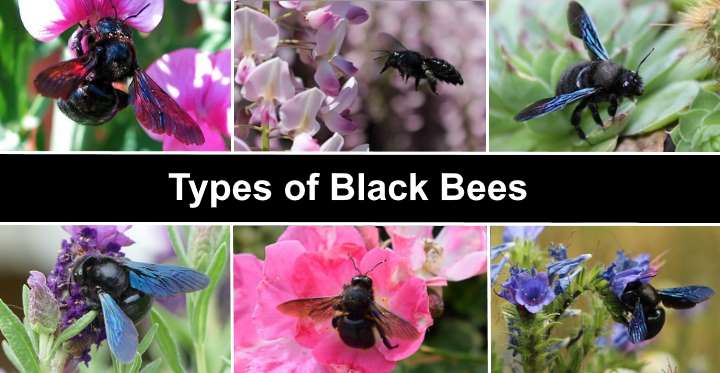
Black bees are about the size of a bumblebee and are also excellent pollinators. In many ways, the habits and characteristics of big black bees are like those of bumblebees. However, black bees are not just black bumblebees. They are a different species of bee that some homeowners view as pests. In fact, if large black bees are causing property damage, you may need to find out ways to get rid of the black bumblebee-like insects.
There is generally nothing to worry about if you notice a big black bee or several bees in your garden. Black bees are generally harmless flying insects, and only the females have stingers. A female is only likely to sting if provoked. Males may seem to act aggressively, but they are harmless because the male black bees can’t sting.
This article is a guide to identifying types of large and small black bees that pollinate flowers. You will also find out how to distinguish between black bees, honey bees, and bumblebees.
What are Black Bees?
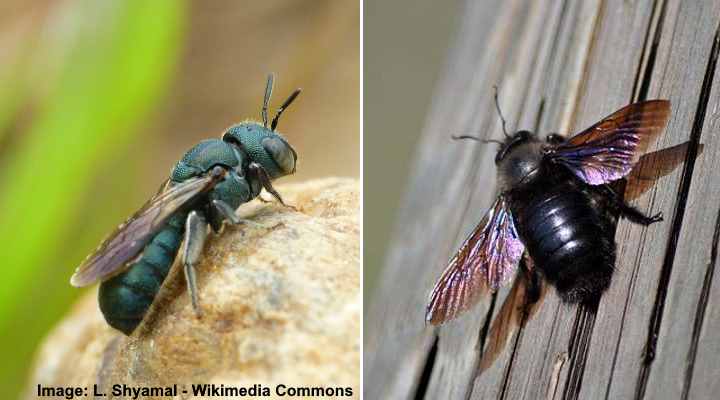
On the left: The small carpenter bee (Ceratina). On the right: The large carpenter bee (Xylocopa)
Black bees are two types of carpenter bees. The large carpenter bee (Xylocopa) is a big black bee with a shiny body, six legs, and two pairs of wings. The small carpenter bee (Ceratina) also has characteristics of carpenter bees, but they have a slender greenish-black metallic body.
Black carpenter bees get their name from their habit of building nests in wood. The black bees burrow tunnels into dead wood, creating nesting tunnels. This way, black bees can cause property damage if they drill into wood structures to create nests and lay eggs.
What Are the Types of Black Bees?
Black bees are classified into two primary genera — Xylocopa and Ceratina. The name carpenter bee describes their habit of creating nesting tunnels by making holes in wood. The Xylocopa genus is more extensive, with about 500 different species of big carpenter bees. There are around 350 species of small black bees in the genus Ceratina.
How to Identify Black Bees
Black carpenter bees look like bumblebees, only without the characteristic yellow bands. It’s easy to spot black carpenter bees due to their shiny, hairless abdomen. Some species of black bees have yellow markings on their thorax, and other small black bees have greenish iridescent shimmering bodies.
Big Black Bee (Xylocopa)
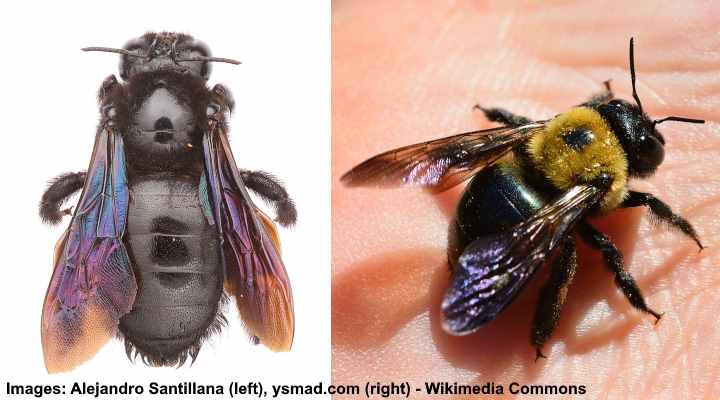
Left: Western carpenter bee (Xylocopa californica). Right: Eastern carpenter bee (Xylocopa virginica)
Carpenter bees in the genus Xylocopa best fit the description “big black bee.” The black carpenter bee has a shiny black abdomen and may have tufts of yellow or white hairs on its thorax, and four wings and six legs. Black bees can measure up to 1” (2.5 cm) long.
Big black bees are common in North America, and there are three species of western black bees and two eastern black bee species. However, there is little difference in the appearance of various species of black bees.
Large black bees are important pollinators and, compared with bumblebees, can pollinate some flowers more effectively. For example, large carpenter bees use “buzz pollination” techniques where their flying motion dislodges pollen from flower anthers.
How to Identify Big Black Bee
To identify a black carpenter bee, look for its shiny black abdomen with a metallic sheen. You’ll notice the characteristic band of fine hairs around the edge of its abdomen. Most species of black bees have an identifiable tuft of hair on their thorax.
Black carpenter bees measure between 0.5” and 1” (1.2 – 2.5 cm) long.
Small Black Bee (Ceratina)

Examples of small black carpenter bees (Ceratina)
Small black carpenter bees in the genus Ceratina have a slender body that is often in dark metallic shades. Up close, you’ll notice tiny fine hairs sparsely covering the bee’s body. Additionally, some carpenter bees may have yellow markings on their face and body. Small carpenter bees measure up to 0.3” (0.8 cm) long.
Compared to large black bees, the small carpenter bee has a slenderer body. Also, the small black bees don’t look like bumblebees; instead, they resemble “sweat bees” because of their iridescent coloration, small size, and slender body.
How to Identify Small Black Bee
To identify a small carpenter bee, look for its black or green metallic-colored body, two short antennae, six short legs, and small wings. Small black bees may have some hairs on their abdomen and thorax, but the bee’s overall appearance is smooth and shiny.
Small black bees only measure 0.3” (0.8 cm) long.
Big Black Bees vs. Bumblebees (with Pictures)
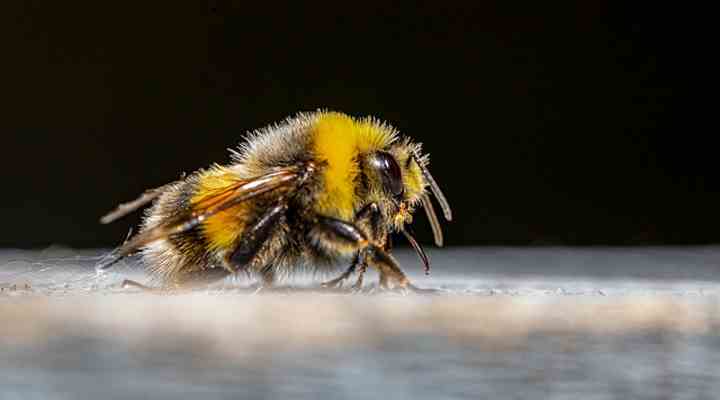
A bumblebee
It’s easy to confuse large black carpenter bees with bumblebees as both species of bees have similar sizes and characteristics. The best way to tell the difference between large black bees and bumblebees is the presence of hairs. So, carpenter bees have a smooth, shiny body, and bumblebees are fuzzy.
Also, black carpenter bees can be completely black without any bands of yellow or yellow hairs. However, some species of carpenter bees have yellow tufts of hair, which makes them easy to confuse with bumblebees.
Let’s look in detail at the main differences between big black carpenter bees and bumblebees.
Big black bee appearance
Carpenter bees have a smooth abdomen without any yellow or black hairs, typical of a bumblebee. Some black bees have a fuzzy yellow thorax which can be confusing. However, their abdomen is always shiny and black.
Carpenter bee nests
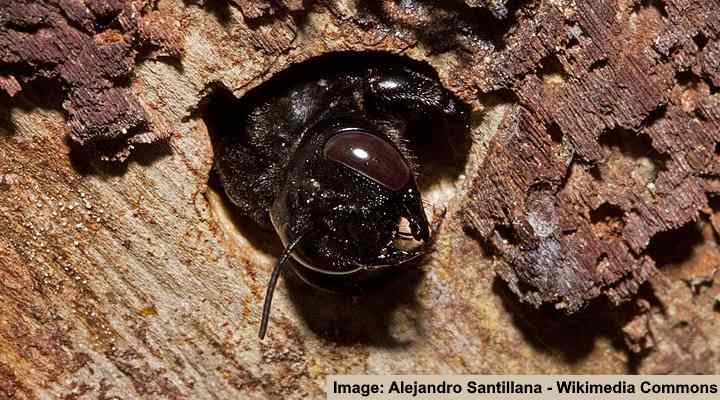
Carpenter bee nest entrance
Unlike bumblebees that build nests in the ground or piles of debris, big black bees tunnel into dead wood to make nests. Carpenter bee nests are 0.37” (0.95 cm) in diameter and can be found in wooden poles, house frames, eaves, dead trees, beams, and the sides of buildings.
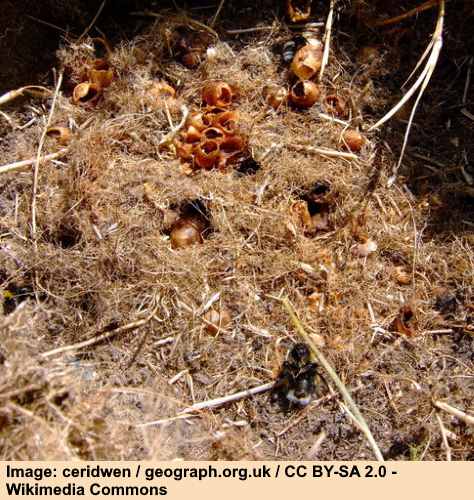
Remains of bumblebees’ nest
Carpenter bee colony
Big black bees don’t live in colonies like bumblebees. For example, carpenter bees are solitary insects, and there is only one female in a nest. On the other hand, bumblebees can live in colonies of up to 400, with the queen bee taking prominence.
Black carpenter bee habits
You’ll tend to notice that big black bees spend time hovering near wooden structures as they excavate their nest to lay larvae. However, the characteristics of bumblebees are that they spend most of their time buzzing from flower to flower to pollinate plants.
Large black bee aggression
Neither big black bees nor bumblebees are typically aggressive. Male carpenter bees have a reputation for aggressive behavior as they buzz around people. However, the black male bees lack stingers, so they can’t do any harm.
Black Carpenter Bees vs. Honey Bees (With Pictures)

A honey bee
Carpenter bees resemble honey bees, only without the characteristic yellow and black bands on a honey bee’s abdomen. However, it’s usually easy to tell big black bees apart from honey bees. For example, a carpenter bee is larger than a honey bee and has a smoother body.
What are the other differences between carpenter bees and honey bees? Here are a few:
- Bee sting—Carpenter bees and honey bees are not aggressive and rarely sting. However, a female carpenter bee can sting multiple times, whereas a honey bee dies after stinging someone.
- Bee nests—Honey bees typically live in hives or hanging nests, whereas black bees build tunnels to lay larvae in.
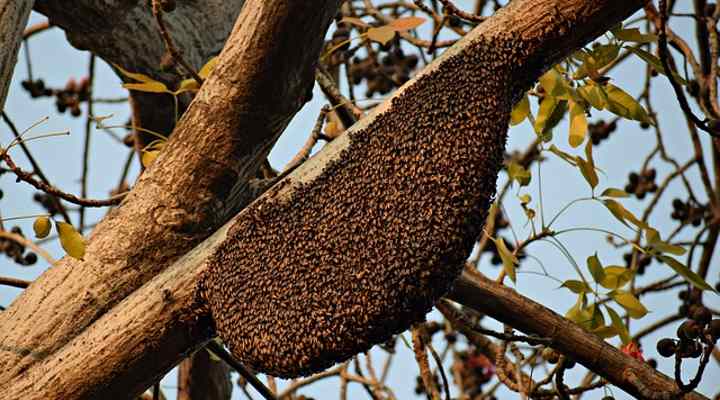
Honey bees nest
- Bee damage—A large infestation of carpenter bees can significantly damage property. But honey bees don’t have destructive habits because they don’t bore into wood.
Do Black Bees Sting?
Female black bees can sting, but it’s rare for carpenter bees to sting humans. Big black bees only sting if the nest is under threat or they feel threatened. Black male bees don’t have stingers and won’t sting. However, they may seem to act aggressively if you get too near to the nest.
Where Do Black Carpenter Bees Live?
Black bees live in nesting tunnels in dead wood during the winter. Females bore into wood such as dead trees, wooden structures, decks, wooden furniture, fence posts, or roof beams, creating a hole in the wood and then a tunnel at right angles.
How to Identify Carpenter Bee Nest

Carpenter bee nest in split wood
It’s easy to identify a big black bee next as you will see perfectly round holes in wood. The nesting holes are typically 0.37” (0.95 cm) in diameter, about the diameter of your little finger or a dime. Sometimes, you may see many openings together that look like someone has drilled multiple holes into the wood.

Another example of carpenter bee nest in split wood
When Are Black Carpenter Bees Active?
Big black bees are active during spring and summer. Females emerge in spring to mate and then lay their eggs. As they construct their nests, you will often notice carpenter bee activity near homes, wooden structures, or dead trees. The flight habit of carpenter bees tends to be erratic, which can make them seem aggressive.
Big black bumblebee-like males may buzz around aggressively if you are near a nesting hole. However, they lack stingers and are harmless. On the other hand, the female has a stinger but rarely uses it because they are not defensive bees.
Do Carpenter Bees Pollinate?
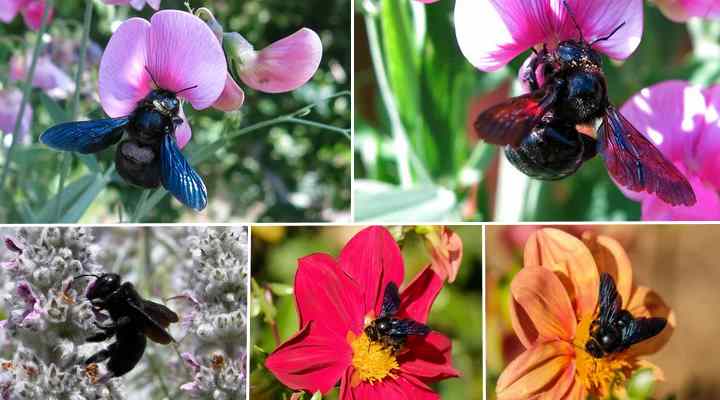
Carpenter bees pollinating flowers
Carpenter bees are beneficial insects because they are excellent pollinators for some plants. Big black bees use a “buzz pollination” method to pollinate certain flowers. Vibrations from the wings cause pollen to land on the bees, and they fly off to pollinate other plants. Carpenter bees pollinate tomatoes, vegetables, eggplant, and many types of flowers.
In some cases, carpenter bees will use their mouthparts to cut the base of the flower and suck the nectar without any pollination taking place. However, carpenter bees are beneficial for pollinating many types of plants.
Do Black Bees Make Honey?
Carpenter bees don’t make honey the same way that honey bees do. Only bees in the genus Apidae are honey producers, and honey production requires bees to live in a social group. However, carpenter bees are solitary bees, and you will never get honey from them.
Are Black Bees Aggressive?
Carpenter bees, especially black male bees, are defensive insects and appear to be aggressive. However, their aggressive buzzing around people’s heads is to protect the nest. Because big and small black male bees don’t sting, they are considered harmless. Likewise, female bees are rarely aggressive and rarely sting.
Are Black Bees Dangerous?
Black carpenter bees are not considered dangerous insects. Although the stingers contain venom, females will only sting if you provoke them. And even then, it takes a lot of provocation for the bees to inflict a sting.
A carpenter bee’s sting may cause local inflammation and pain, similar to most bee stings. However, bee stings can become dangerous if you are allergic to them. Signs of a bee sting allergy include a swollen tongue, breathing difficulties, nausea, dizziness, and even loss of consciousness. Therefore, it’s crucial to seek emergency medical help if anyone shows signs of anaphylaxis.
How to Get Rid of Black Bees (Prevention and Control)
Although black carpenter bees are beneficial flying insects, their wood-boring habits can cause a lot of damage. So, many homeowners look for ways to prevent carpenter bees from causing damage to decks, wooden furniture, fence posts, building facades, or other wooden structures.
Prevention is the best way to prevent carpenter bees from becoming a nuisance. It’s a good idea to apply untreated wood in early spring with almond oil to act as a carpenter bee deterrent. Additionally, you can set up alternative places for bees to nest so they avoid your home or shed.
Here are some ways to control black bees in your yard:
Black carpenter bee traps
One way to control carpenter bees is to set up bee traps. The trap is a small wooden box consisting of a small hole the size of a bee nest entrance. The base of the box has a large hole with a plastic water bottle attached.
The bee trap works by attracting bees looking to nest in existing nesting sites. They enter the hole and drop down into the plastic bottle, and can’t get out. You can hang the bee traps near eaves, overhangs of your house, on decks, patios, or on a shed.
Paint exposed wood to prevent black bees
Carpenter bees don’t bore into painted surfaces. So, a great way to protect unfinished wooden structures is to paint them. This way, females looking to create a new nest will fly to other suitable places to drill holes to lay eggs.
If you prefer to leave wood unpainted, you can apply almond oil to wooden surfaces every spring before carpenter bees become active.
Top tip for carpenter bee prevention: Keep doors to outbuildings, sheds, and garages closed throughout spring to prevent big black bees from making nesting sites indoors.
Fill abandoned black bee nests
Suppose there are already nesting holes in your home, deck, patio, or fence posts. In that case, you can fill up abandoned holes to prevent females from nesting there again the following year.
Overwintering adult carpenter bees emerge in spring and then lay eggs. New black bees hatch and then leave the nest in late summer. At the end of summer, fill abandoned nests with steel wool, spray foam insulation, or wadded aluminum foil and then cover with a thick layer of caulk.
You can then paint over the surface to protect the wood from more nesting activity
Set up bee hotels to prevent black bee damage to property
Some homeowners set up nesting boxes for bees to lure them away from the property or deck area. The idea is that carpenter bees see these “bee hotels” as an easy alternative to drilling a nest in a tree, wooden beam, or other pieces of wood.
Although this method may have limited success, preventing carpenter bees from boring into your home, furniture, or deck is more effective. Bee hotels are better for mason bees or attracting other pollinators and beneficial insects.
Black Bee Damage
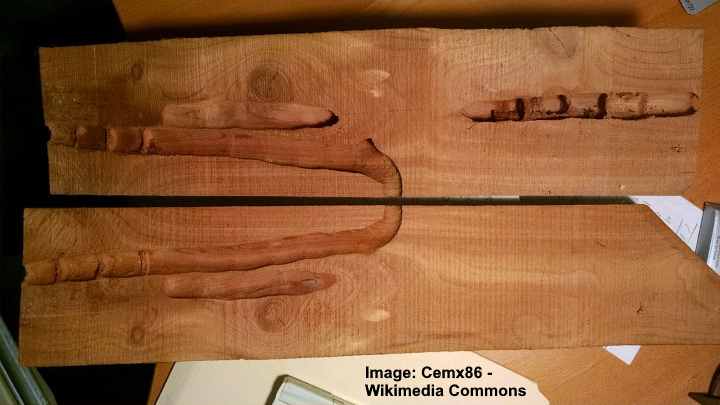
Carpenter bee damage to wooden post
Carpenter bee damage may not be as severe as termite damage, but it can cause noticeable wood damage. After a few years of black bee damage or a significant infestation, the wood could be full of holes. In extreme cases, a large number of holes could weaken a wooden structure.
Carpenter bees tunnel into the wood about 1” (2.5 cm) deep and then 4” to 6” (10 – 15 cm) long at right angles along the grain. From the outside, you will not see the damage in the wood. However, over the years, wooden beams with many black bee nests can become almost perforated. In some cases, carpenter bee nests have been found up to 10 ft. (3 m) long.
Apart from the dime-sized hole in wood, other signs of carpenter bee damage include sawdust below the hole and discoloration around the hole from bee feces.
Another way how black bees indirectly damage property is because of woodpeckers. Carpenter bees are a delicacy for woodpeckers, and they will peck holes into nests to get to the larvae for a tasty treat.
Black Bee Benefits
Carpenter bees have many benefits in the ecosystem, and they are harmless compared to aggressive wasps. First, big and small black bees are effective pollinators. Black bee pollination can help increase your yield of certain vegetables and boost flowering. Also, many birds feed on black bees and their larvae.
So, if you can prevent carpenter bees from nesting in your home’s structure, shed, outbuilding, patio, or furniture, they can be beneficial insects for your garden landscape.
Related articles:
